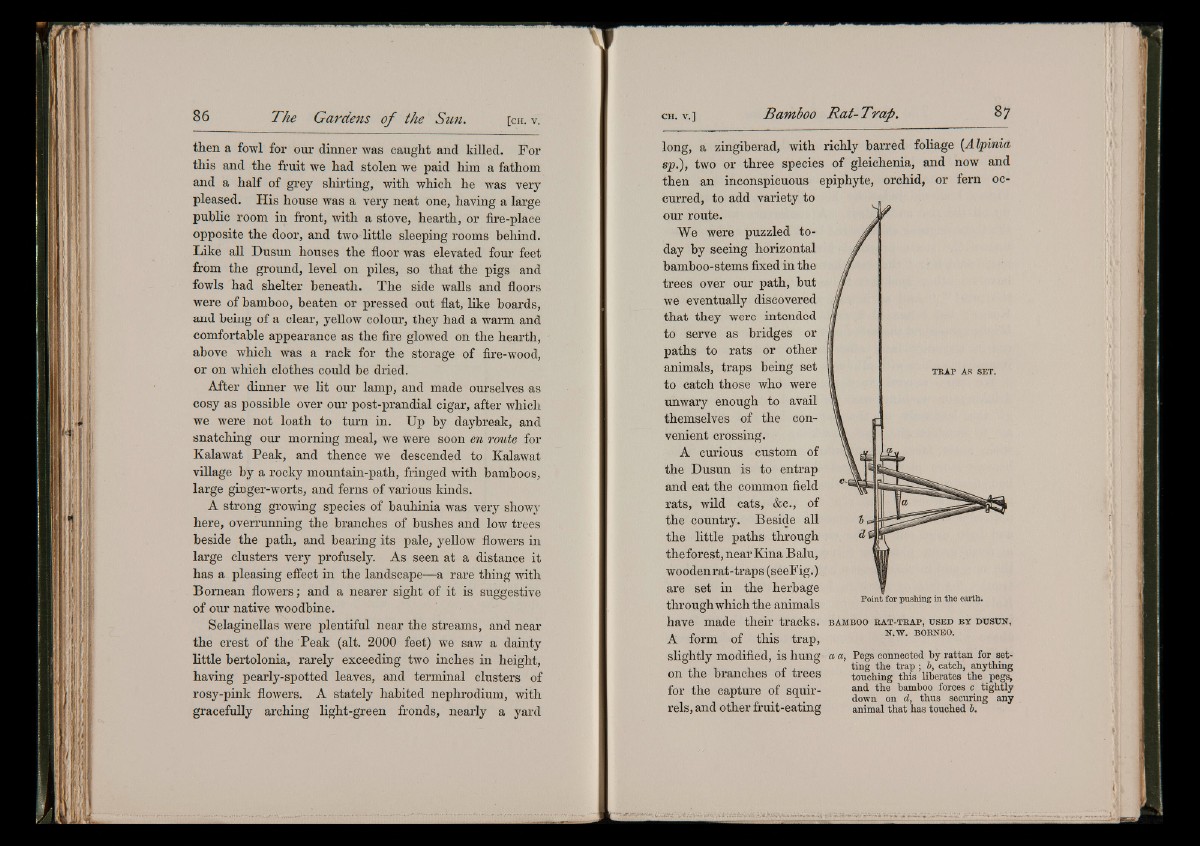
then a fowl for our dinner was caught and killed. For
this and the fruit we had stolen we paid him a fathom
and a half of grey shirting, with which he was very
pleased. His house was a very neat one, having a large
public room in front, with a stove, hearth, or fire-place
opposite the door, and two little sleeping rooms behind.
Like all Dusun houses the floor was elevated four feet
from the ground, level on piles, so that the pigs and
fowls had shelter beneath. The side walls and floors
were of bamboo, beaten or pressed out flat, like hoards,
and being of a clear, yellow colour, they had a warm and
comfortable appearance as the fire glowed on the hearth,
above which was a rack for the storage of fire-wood,
or on which clothes could be dried.
After dinner we lit our lamp, and made ourselves as
cosy as possible over our post-prandial cigar, after which
we were not loath to turn in. Up by daybreak, and
snatching our morning meal, we were soon en route for
Kalawat Peak, and thence we descended to Kaiawat
village by a rocky mountain-path, fringed with bamboos,
large ginger-worts, and ferns of various kinds.
A strong growing species of bauhinia was very showy
here, overrunning the branches of bushes and low trees
beside the path, and bearing its pale, yellow flowers in
large clusters very profusely. As seen at a distance it
has a pleasing effect in the landscape—a rare thing with
Bornean flowers; and a nearer sight of it is suggestive
of our native woodbine.
Selaginellas were plentiful near the streams, and near
the crest of the Peak (alt. 2000 feet) we saw a dainty
little bertolonia, rarely exceeding two inches in height,
having pearly-spotted leaves, and terminal clusters of
rosy-pink flowers. A stately habited nephrodium, with
gracefully arching light-green fronds, nearly a yard
long, a zingiberad, with richly barred foliage (Al/pinia
sp.), two or three species of gleichenia, and now and
then an inconspicuous epiphyte, orchid, or fern occurred,
TRA P AS SET.
to add variety to
our route.
We were puzzled today
by seeing horizontal
bamboo-stems fixed in the
trees over our path, but
we eventually discovered
that they were intended
to serve as bridges or
paths to rats or other
animals, traps being set
to catch those who were
unwary enough to avail
themselves of the convenient
crossing.
A curious custom of
the Dusun is to entrap
and eat the common field
rats, wild cats, &c., of
the country. Beside all
the little paths through
the forest, near Kina Balu,
woodenrat-traps (seeFig.)
are set in the herbage
through which the animals
have made their tracks.
A form of this trap,
slightly modified, is hung
on the branches of trees
for the capture of squirrels,
and other fruit-eating
P o in t f o r p u s h in g in th e e a rth .
BAMBOO R A T -T R A P , U SED BY D U SU N ,
N .W . BORNEO.
a a, Pegs connected by rattan for setting
the trap ; b, catch, anything
touching this liberates the pegs,
and the bamboo forces c tightly
down on d, thus securing any
animal that has touched b.